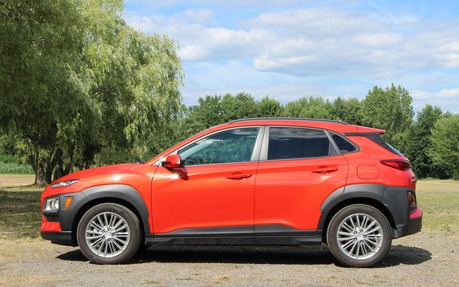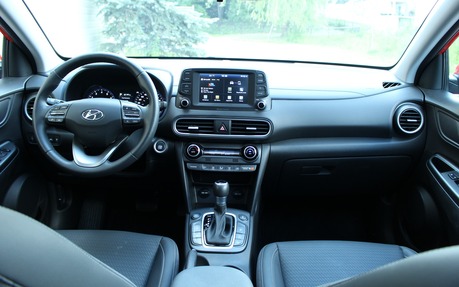2018 Hyundai Kona: Like an Air Freshener
The subcompact SUV segment has been around for a while now, and new models are being added on the market with every passing year. Consumers are trading in their cars and scooping up these little vehicles, which are admittedly more car-like than truck-like.
In addition to popular or long-standing players such as the Mazda CX-3, the Honda HR-V, the Chevrolet Trax, the Mitsubishi RVR, the Jeep Renegade, the Subaru Crosstrek and the Kia Soul, among many others, the Nissan Qashqai and Nissan Kicks, the Ford EcoSport, the Toyota C-HR and the Hyundai Kona have been introduced in the past two years.
- Also: The 2019 Hyundai Kona Electric is a Guaranteed Home Run
- Also: 2018 Hyundai Kona: Among the Best
However, no model seems to have made a splash like the Kona did. It screamed “cannonball!” as it jumped in the pool, sending waves in the faces of its adversaries. The numbers speak for themselves: in the first nine months of 2018 in Canada, the Kona outsold every other subcompact SUV except the Qashqai and the Crosstrek. Not a bad start.
The little Hyundai’s design can definitely be credited as the main factor for its success. It’s modern, sophisticated, cheery and urban. We can add a few more adjectives here. It can please both a younger crowd and empty-nesters alike, something the also-funky C-HR isn’t managing to do right now.
Base trims are equipped with a 2.0-litre four-cylinder engine that develops 147 horsepower—the same one found in the Elantra sedan. It’s matched to a six-speed automatic transmission, and most Canadian buyers are likely to splurge for the available all-wheel drive.

Adding a little excitement to the driving experience is a turbocharged, 1.6-litre four that produces 175 horsepower and 195 pound-feet of torque, connected to dual-clutch, seven-speed automatic. A worthwhile option if we’re willing to spend more money on a Kona, but we recommend keeping the 2.0-litre engine in the case of a long-term purchase, as turbocharged mills and dual-clutch gearboxes should normally require more maintenance over time.
With the base powerplant, we managed an average of 8.4 L/100 km, which is pretty good considering the Kona’s city/highway ratings are set at 9.2/7.8 L/100 km with the all-wheel drivetrain. The Hyundai isn’t as fun to drive as some of its rivals—the CX-3 immediately comes to mind—but it’s far from boring and easy to squirt though city traffic. The Sport drive mode quickens the transmission’s reflexes, although it doesn’t transform the vehicle into a hot rod in any way.
No subcompact SUV can be considered spacious, but the HR-V, Crosstrek and Renegade are the roomiest of the bunch. The Kona falls mid-pack in regards to passenger volume, and its diminutive size can especially be felt when climbing into the rear-seat area, as there’s very little foot space back there. Cargo space is rated at 544 litres with the rear seatbacks up, 1296 with the seats folded down—a little on the small side, but still adequate for the weekly trip to the grocery store.
The 2018 Hyundai Kona’s exterior design does come with the compromise of challenging outward visibility. The rear window is small, and the wiper manages to cover about half of the window surface, which will become glaringly obvious during the winter season.

Inside the Kona 2.0L Luxury AWD trim level, the one we tested here, we find perforated leatherette upholstery with light contrast stitching, a leather-wrapped and heated wheel, a seven-inch infotainment touchscreen and heated front seats. It also includes blind spot monitoring as well as lane-departure warning and prevention, although the latter is somewhat irritating, as the steering wheel constantly squirms in our hands trying to correct the vehicle’s trajectory. We’re always tempted to deactivate this feature, which defeats the purpose of having it.
Pricing starts at $20,999 before freight and delivery charges, and we think the most interesting version could be the 2.0L Preferred AWD which retails for $24,749. It’s no more or less expensive than most of its rivals, but the Kona does offer lots of features for the asking price—a Hyundai trademark.
The 2018 Hyundai Kona shouldn’t be considered a family vehicle, but we can say the same thing for almost every other subcompact SUV on our market. Rather, it’s a trendy, loveable little vehicle for those who stick to the “active lifestyle” cliché, with good fuel economy and the added safety feel of all-wheel drive. It’s not the most amusing or the most versatile model in its segment, but it does everything well, and is a breath a fresh air in an otherwise conservative vehicle segment.
| Test drive report | |
| Test model | 2018 Hyundai Kona |
|---|---|
| Trim level | Luxury 2.0 AWD |
| Price range | $22,749 – $24,749 |
| Price as tested | 27 499 $ |
| Warranty (basic) | 3 years/60,000 km |
| Warranty (powertrain) | 5 years/100,000 km |
| Fuel economy (city/highway/observed) | 9,2 / 7,8 / 8,4 L/100km |
| Options | N/A |
| Competitive models | Chevrolet Trax, Ford EcoSport, Honda HR-V, Jeep Renegade, Kia Niro, Mazda CX-3, MINI Countryman, Nissan Kicks, Nissan Qashqai, Subaru Crosstrek, Toyota C-HR |
| Strong points |
|
| Weak points |
|
| Editor's rating | |
| Fuel economy | The 2.0-litre engine can be quite efficient. |
| Comfort | The suspension is slightly stiff, but it’s not a major issue. |
| Performance | With 147 horsepower on tap, the Kona is as speedy as the majority of its rivals. |
| Infotainment | Easy to use, a reactive touchscreen, Apple CarPlay/Android Auto integration. |
| Driving | Not the most amusing subcompact SUV on the market, but fun nonetheless. |
| Overall | It does everything well and looks pretty good doing so. The current subcompact SUV to beat. |
